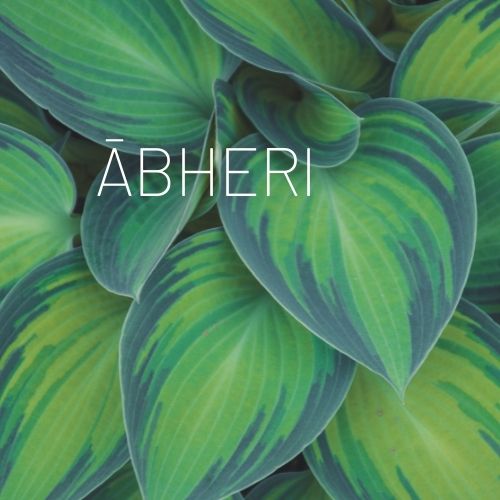
| Origin: |
|
Hindustani equivalent: Dhanasri, Bimplas |
Abheri (pronounced ābhēri) is a raga in Carnatic music (musical scale of South Indian classical music). It is a Janya raga (derived scale), whose Melakarta raga (parent, also known as janaka) is Kharaharapriya, 22nd in the 72 Melakarta raga system.
Details about the raaga: Abheri
Bhimpalasi (or Bheempalas) of Hindustani music sounds close to Abheri. This raga is closer to another raaga, Bhagyasree as for Bhagyasree Gandharam is sung softly. Thus a subtle difference of Gandhara makes a listener to feel this raga as Bhagyasree.
There are some differing views on swaras in the scale of Abheri. It is considered a Bhashanga raga (scale has an anya swara, that is, a note which is not in the parent melakarta raga, in this case Kharaharapriya raga), with introduction of Suddha Dhiavatham (D1) in some phrases of the raga. A different view is that this raga is a janya of Natabhairavi (which has D1, suddha dhaivatham, in place of D2), with D2 being the anya swara (external note).
Abheri’s notes when shifted using Graha bhedam, yields 3 other janya rāgams, namely, Mohanakalyani, Kedaragaula and Arabhi (if we consider the Kharaharapriya-based scale). Graha bhedam is the step taken in keeping the relative note frequencies same, while shifting the Shadjam to the next note in the rāgam. In case of Janya ragams, only notes that occur in both ascending and descending scale are taken for this change. Abheri has close resemblance to Karnatakadevagandhari and Bhimpalasi. Whether they are essentially same is a matter of debate among the musicologists.
The notes(swaras) in this scale are:
Chathusruthi Rishabham, Sadharana Gandharam, Suddha Madhyamam, Chathusruthi Dhaivatham, and Kaisiki Nishadham.
Murchana | Raaga Lakshana of Abheri
Aarohaṇa |
|
Avarohaṇa |
Abheri Sancharana | Prayogas | Chalan
| GMPN, | D,,P- PG, | M PNS | NSR NS | PNSGRNS |
| GR, NP, GR, NP, S | NDPM | GRS | NSPNS | GRS |
| SGMPGM | GRSNDP | PNSGMP | GM, | GMPNDP |
| MPGMPNS | NDPMGMGRS | NSGMPNS | PNS | NSGRS |
| NDP | GMPNS | NSGM | GMGRS | NSGMP |
| GMG,RS | NDP | MPGM | PSNDP | NDPM |
| Note: G,N are given kampitha gamakam like SMGM and PSNS | ||||
Abheri Features
Melakarta/Janya | Thaat |
It is a Janya raga (derived scale), whose Melakarta raga (parent, also known as janaka) is Kharaharapriya, 22nd in the 72 Melakarta raga system. |
Chakra |
Veda(Kharaharapriya) |
Evokes (rasas) |
Abheri evokes courage and establishes power. Abheri has a positivive penetrating effect on human mind and (sustained) positive effect that would remain for days. |
Performance time |
Late Morning: 2. 10 AM |
Raga type |
An Oudava Sampoorna ( meaning it takes SGMPN – five notes in the ascent and SNDPMGR in the descent). |
Notes
Abheri is a very old ragam mentioned in Pre Trinity times during Tulaja and Venkatamakhin. From those times there existed two versions of the same ragam.
Abheri as inscribed by Govinda acharya (followed by Saint Thyagaraja) :- Abheri a janyam of Natabhairavi and follows the scale
S G3 M1 P N2 S and S N2 D1 P M1 G2 R2 N2 S
The dhaivatham value is given as dwisruthi dhaivatham (same as Mayamalawagowla) and thus represented as D1. The original Nagumomu is composed in this structure. Kanda Vandarul by Papanasam Shivan also uses this form of Abheri.
Abheri as inscribed by Muddu Venkatamakhin (followed by Muthuswami Deekshitar) :- Abheri is a janyam of Narireethigowlai (20th melam). It follows the scale
S M1 G2 M1 P P S S and S N2 D1 P M1 G2 R2 S
The krithi Veenabheri uses this structure. The Pa Sa and P P Sa prayogams are evident in the krithi. MSS sings kalpana swarams adhering correctly to this structure. I have shared a link at the bottom. The ragamudra in the krithi is clear in the starting pallavi.
Devagandharam as inscribed by Muddu Venkatamakhin (followed by Deekshitar)
A closely allied ragam, of Abheri, this belong to the 22nd melam of Sree Ragam. The structure of the ragam is thus
S G2 M1 P N2 S and S N2 D2 P M1 G2 R2 S.
The krithis Panchaspeeta roopini and Kayarohanesham follows this ragam and the ragamudra is again evident.
Compositions in Abheri
Nagumomu Kanaleni | Composer : Tyagaraja | Sung by: Dr Balamuralikrishna
Nagumomu Kanaleni | Composer : Tyagaraja | Sung by: M. S. Subbulakshmi
Bhajare Re Manasa | Composer : Mysore Vasudevachar | Sung by: Smt. Ananya Ashok
Panchashatpeetha Roopini | Composer : Dikshitar (Karnataka Devagandhari) | Sung by: Ranjani and Gayatri
Strings Attached | violin and Veena: Dr. Jayanthi Kumaresh & Shri R Kumaresh
Thrilling Alapana | Violin: Ganesh & Kumaresh
Reference:
- Plagiarism. 22 July 2003, 10:55 UTC. In Wikipedia: The Free Encyclopedia. Wikimedia Foundation Inc. Encyclopedia on-line. Available from https://en.wikipedia.org/wiki/Plagiarism. Internet. Retrieved 10 August 2004.
- Chinna Satyanarayana, Nookala. 2004. Raagaas of Indian music: a comprehensive descriptions of 254 raagaas of Carnatic music, 47 raagas of Hindustani music and a few western scales with notations.